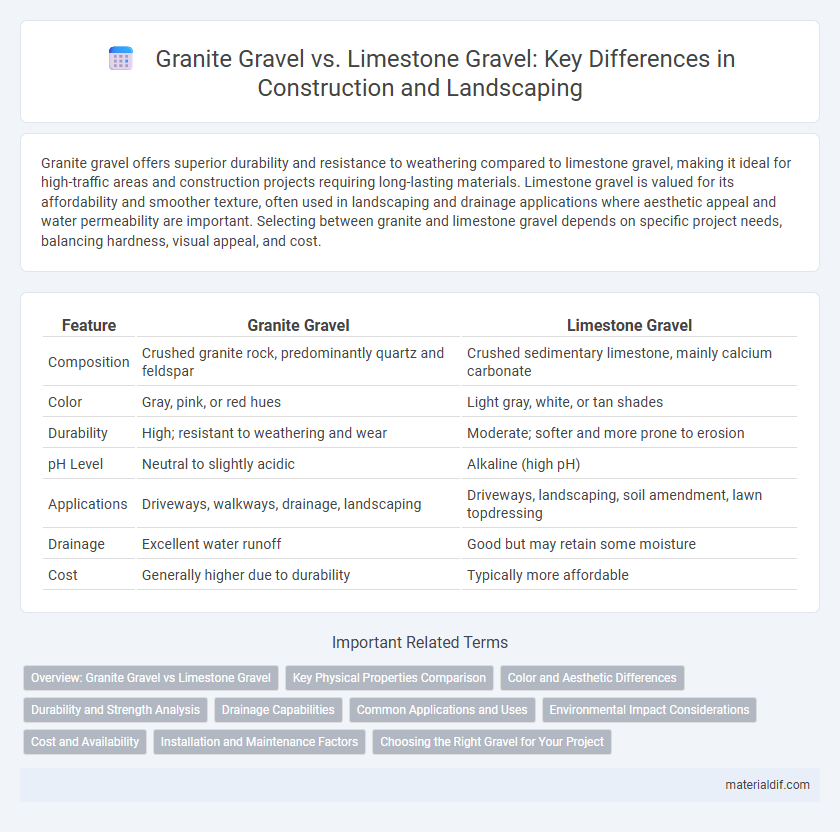Granite gravel offers superior durability and resistance to weathering compared to limestone gravel, making it ideal for high-traffic areas and construction projects requiring long-lasting materials. Limestone gravel is valued for its affordability and smoother texture, often used in landscaping and drainage applications where aesthetic appeal and water permeability are important. Selecting between granite and limestone gravel depends on specific project needs, balancing hardness, visual appeal, and cost.
Table of Comparison
| Feature | Granite Gravel | Limestone Gravel |
|---|---|---|
| Composition | Crushed granite rock, predominantly quartz and feldspar | Crushed sedimentary limestone, mainly calcium carbonate |
| Color | Gray, pink, or red hues | Light gray, white, or tan shades |
| Durability | High; resistant to weathering and wear | Moderate; softer and more prone to erosion |
| pH Level | Neutral to slightly acidic | Alkaline (high pH) |
| Applications | Driveways, walkways, drainage, landscaping | Driveways, landscaping, soil amendment, lawn topdressing |
| Drainage | Excellent water runoff | Good but may retain some moisture |
| Cost | Generally higher due to durability | Typically more affordable |
Overview: Granite Gravel vs Limestone Gravel
Granite gravel is composed of coarse, angular particles with high durability and excellent drainage properties, making it ideal for construction and landscaping projects requiring strength and stability. Limestone gravel features softer, rounded particles with higher porosity and a tendency to compact more easily, offering better nutrient content for soil applications and enhanced aesthetic appeal in walkways. Both types differ significantly in mineral composition, hardness, and long-term performance, influencing their suitability for various industrial and decorative uses.
Key Physical Properties Comparison
Granite gravel is denser and more angular, providing superior compaction and drainage compared to the softer, more rounded limestone gravel. Limestone gravel offers higher alkalinity, which can affect soil pH and is more prone to erosion under acidic conditions. The hardness of granite gravel, rated around 6-7 on the Mohs scale, enhances its durability, whereas limestone is softer, typically around 3-4, making it less resistant to weathering.
Color and Aesthetic Differences
Granite gravel features a wide range of colors, including pink, gray, red, and black, providing a more textured and vibrant appearance ideal for decorative landscaping. Limestone gravel generally presents in softer, more muted tones like white, cream, and beige, offering a classic, clean look that enhances natural surroundings without overpowering them. These aesthetic differences influence their use, with granite preferred for bold, colorful designs and limestone chosen for subtle, neutral palettes.
Durability and Strength Analysis
Granite gravel exhibits superior durability and strength due to its dense, interlocking crystal structure, making it ideal for heavy-duty construction applications. Limestone gravel, while less dense and softer, is more susceptible to weathering and fragmentation under high-stress conditions, reducing its longevity in load-bearing scenarios. The mineral composition of granite provides higher resistance to abrasion and crushing compared to the calcite-rich limestone, ensuring enhanced structural stability.
Drainage Capabilities
Granite gravel offers superior drainage capabilities due to its angular, coarse texture that prevents water from pooling, making it ideal for areas requiring efficient water runoff. Limestone gravel tends to compact more easily, reducing permeability and potentially causing slower drainage, which can lead to water retention issues in poorly draining soil. Choosing granite gravel enhances soil aeration and minimizes erosion risks, critical for construction and landscaping projects demanding optimal drainage performance.
Common Applications and Uses
Granite gravel is commonly used in heavy-duty construction projects such as road bases, driveways, and erosion control due to its hardness and durability. Limestone gravel is favored for landscaping, garden pathways, and drainage systems because of its softer texture and ability to bind well with other materials. Both types effectively enhance structural stability but serve distinct purposes depending on project requirements.
Environmental Impact Considerations
Granite gravel is typically more environmentally friendly due to its natural durability and slower erosion rate, reducing sediment runoff in landscapes. Limestone gravel, although often sourced locally, can contribute to soil alkalinity changes and higher dust emissions during extraction, impacting nearby ecosystems. Choosing granite gravel supports longer-lasting surfaces with fewer environmental disturbances compared to limestone alternatives.
Cost and Availability
Granite gravel generally costs more than limestone gravel due to its durability and limited quarry sources, making it slightly less available in some regions. Limestone gravel tends to be more affordable and widely available because of abundant deposits and lower extraction costs. Cost and availability are key factors for construction projects prioritizing budget and material accessibility.
Installation and Maintenance Factors
Granite gravel offers superior durability and resistance to weathering, making it ideal for installation in high-traffic areas, while limestone gravel, being softer, requires more frequent replenishing and maintenance. The angular shape of granite gravel enhances interlock stability during installation, reducing movement and compaction, whereas limestone's rounded edges may lead to quicker displacement under pressure. Maintenance for granite gravel typically involves minimal upkeep beyond occasional raking, whereas limestone gravel demands more regular attention to prevent erosion and dust accumulation.
Choosing the Right Gravel for Your Project
Granite gravel offers exceptional durability and resistance to weathering, making it ideal for high-traffic driveways and construction foundations. Limestone gravel, with its alkaline properties and smoother texture, provides better compaction and drainage, suitable for landscaping and walkways. Selecting the right gravel depends on project requirements such as load-bearing capacity, aesthetic preference, and soil compatibility.
Granite Gravel vs Limestone Gravel Infographic

 materialdif.com
materialdif.com